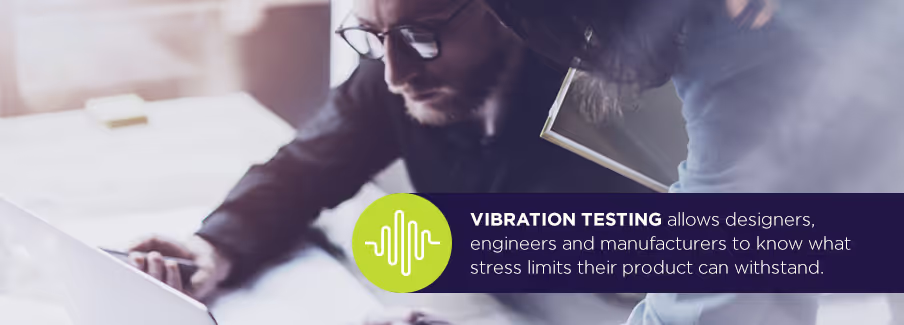
A founding physics principle states that every object vibrates to some degree. That can be at the micro level, where atomic and sub-atomic particles vibrate at slow or fast rates. Vibrations also happen at the macro level, where huge objects experience environmental forces causing them to move. It’s fair to state that vibrations are inescapable facts of life, and they’re necessary factors in a fluid world.
In technical terms, vibrations are mechanical oscillations that respond to forces pushing objects outside their equilibrium or resting point. These highs and lows, or back and forth swings, are measurable. They relate in terms like frequency, waveforms and spectrums. Vibrations respond directly to timed intervals that can be measured using suitable product vibration testing equipment.
Vibrations can be periodic with specific wave intervals, like pendulums in mechanical clocks. Or they can be random, such as vehicle suspensions responding to a rough gravel road. Vibrations can also happen to static devices like electronic equipment sitting on a shelf where external forces cause them to shake. They can also occur in mobile equipment such as engines and fans that produce internal forces, causing them to vibrate.
Many mechanical vibrations are desirable outcomes of planned design. Loudspeakers are good examples where vibrations are intentional to produce sound. However, some vibrations are undesirable and result from improper design or fair wear and tear on equipment out of balance or improperly tuned. Whether vibrations are intentional or unintentional, there are precise vibration testing services and vibration testing standards available to verify parameters. These vibration testing facilities can determine whether oscillations are inside or out of tolerable range.
Products are vibration tested to determine limits and tolerances. Every product is vulnerable to vibration loads and potential breakage or failure. That includes tiny objects like microprocessors and circuit boards right up to giant structures like bridges and skyscrapers.
Vibration testing allows designers, engineers and manufacturers to know what stress limits their product can withstand. Testing through vibrations ensures the product is qualified for its intended purpose and meets safety and regulatory standards, as well as complies with any International Standards Organization (ISO) requirements. Part of due diligence in vibration testing determines fatigue testing, failure limits and structural integrity screening.

Many industries routinely use vibration testing as part of their quality control program. Finding out what vibrations a product withstands before release makes good business sense. Known limitations allow the end user to employ their product safely and put it into trouble-free service. Testing for vibration resistance prevents product recall, supports warranty conditions and provides excellent product purchase value.
Many different industries use vibration testing as part of their manufacturing process. Leading manufacturers want to ensure product reliability. Vibration testing is part of building credibility, and it also protects the manufacturer’s integrity and reputation. These are some of the industries that typically use vibration testing during product development:
Not all vibration types are the same. However, all vibrations have common characteristics that place them within defined parameters. Those parameters are the equilibrium or neutral point when at rest and the far or extreme points when in motion.
Ocean waves are one of the best vibration examples, as they respond to changing environmental conditions that upset them from their equilibrium point, which is flat, calm water. Wind, tides, currents and freshwater outflow cause water surfaces to oscillate. The flat surface turns into high points at the wave crests and low points at the wave troughs. How high and deep waves oscillate, as well as how far apart waves occur, is called frequency.
The same principle applies throughout the physical world. Regardless of if it’s water or solid mass, every physical entity can vibrate according to what external or internal forces affect them. There are three separate types of vibrations:

There are two distinct vibration testing types. One is preliminary vibration testing where devices undergo a rigorous and sophisticated examination to help improve product design. This normally happens in a clinical setting like a shock and vibration testing lab or research and development facility.
Vibration testing and analysis allows manufacturers to stretch stresses and strains to the breaking point. This sets product parameter limits and maximum tolerances. Knowing limitations is extremely important in critical evaluations like spacecraft vibration testing.
The other type of vibration testing type is secondary evaluation. This applies to products and equipment already in service. Vibration testing is invaluable for maintaining peak performance or predicting potential failure. Expensive, dangerous or catastrophic failures happen when huge machines suffer vibrations from internal or external forces causing them to wear, stop or explode.
Both vibration testing types are ounces of prevention paying off in pounds of cure. Good product designers and manufacturers do preliminary evaluation throughout the production procedure. Engineers plan for vibration loads and tolerances, but they can only do so much on a computerized model. At some point, products need vibration testing in the real world and under actual force loads.

Vibration testing in a controlled facility is a precise and exacting procedure. Trained professionals use sophisticated machines to test all types of products for vibration tolerances. Generally, the larger the product is, the bigger the testing machinery needs to be. Testing weights can go from a few ounces to thousands of pounds.
Vibration testing equipment pieces are often called shakers. That’s a simplistic term for a complicated instrument. In its essence, vibration testing comes down to shaking a product. However, the way it’s done and the manner data extracts take a lot of experience to get meaningful information.
Products being vibration tested in a specialized testing facility are fixed to a table on top of the mechanized shaking instrument. Most vibration testing machines have some type of clamping device that holds the unit being tested to the vibration table. Some clamps are spring activated. Other units secure their unit through multiple bolts and restraining plates referred to as a test fixture. Test fixtures are often custom built for the specific part being tested.
Once secured, the vibration instrument, or shaker, activates through operator-controlled power amplifiers and exciter controls. These variable adjustments let the vibration analyst vary the rate and speed of vibrations introduced to the device under testing (DUT). Two varied measurements gather meaningful data from the vibration test, allowing the analyst to conclude the product failure point. Measurements include:
Computerized recordings of vibration tests give the analyst two types of information. This lets the analyst know what’s happening to the DUT when they change stress levels like resonance resistance, amplitude scales and frequency alternations. The two computer scales include:

Controlled vibration testing incorporates three different shakers or vibrating machines. All three designs have features letting the operator or vibration testing specialist control the speed, frequency and other testing variables the product goes through. Each vibration shaker has its pros and cons:
The two common vibration tests involve frequencies introduced in either sine or random vibration patterns. Sine is a linear vibration pattern that’s also referred to as sinusoidal vibration testing. It involves vibrations administered at the same rate throughout the test.

Sine vibration testing is suitable for low-risk products intended for light- and medium-duty applications. That’s fine for many products, but the real world is far from static. Heavy-duty products have all sorts of vibration challenges that range from low frequency and amplitude oscillations to extremely high conditions.
Advanced vibration testing usually uses random vibration patterns. Sophisticated shakers let the operator introduce vibrations at a random and unpredictable rate. This gives the DUT wide exposure to changing conditions they’d expect to find outside of the controlled facility and out in the real world.
Vibration testing is a precise and reliable way to evaluate how products will perform in daily use and under every condition they can reasonably expect to experience. To ensure integrity and dependability for vibration testing, the industry responds to rigid standards set by recognized institutes. These are the guidelines and oversights found in the vibration testing industry:
NTS is a leading supplier of certification and testing for clients in aerospace, defense, the automotive industry and many other areas. Since our earliest days of detecting window leaks in 1961, we have provided comprehensive testing services to ensure you meet the demands in your industry.
This wide range of expertise gives NTS the flexibility to be creative. We find custom solutions to customer testing problems, including vibration testing. For more information, call NTS today at (844) 332-1885 or contact us online.